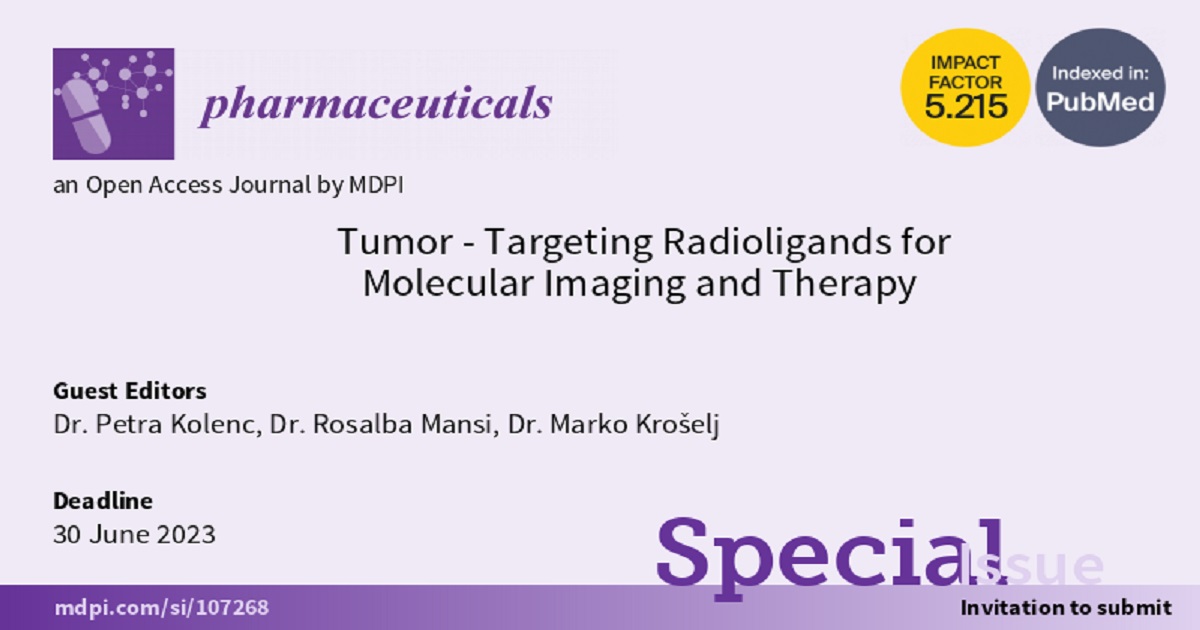Tumor-Targeting Radioligands for Molecular Imaging and Therapy
A special issue of Pharmaceuticals (ISSN 1424-8247). This special issue belongs to the section "Radiopharmaceutical Sciences".
Deadline for manuscript submissions: closed (30 June 2023) | Viewed by 18107

Special Issue Editors
Interests: radiopharmacy; tranlational studies; peptide-based radiopharmaceuticals; molecular imaging
Interests: anti-tumour drug design and synthesis; nuclear imaging; targeted radionuclide therapy; preclinical development of novel peptide-based radiopharmaceuticals; radiopharmacy
Special Issue Information
Dear Colleagues,
Cancer is one of the leading causes of death worldwide. Timely diagnosis of the disease is of utmost importance to support informed decision making and to improve therapy efficacy. Radiopharmaceuticals are vital components of nuclear medicine encompassing such diagnostic methods as single-photon emission computed tomography (SPECT) or positron emission tomography (PET). The increasing development and successful clinical translation of novel radiopharmaceuticals for cancer therapy, such as [177Lu]Lu-DOTATATE and [177Lu]Lu-PSMA-617 paved the way for new and exciting research in the field of nuclear medicine.
Although various large molecules or nanoparticles are persistently taking their part in new radiopharmaceutical developments, the majority of radiopharmaceuticals still belong to smaller molecules – radioligands, such as radiolabeled amino acids, peptide-based molecules, peptidomimetics, small-molecule inhibitors targeting e.g. prostate-specific membrane antigen (PSMA) or fibroblast activation protein (FAP), etc. One of the most important features of the radiopharmaceuticals with low molecular weight compared to larger molecules is their favourable pharmacokinetics. With high capillary permeability, fast penetration from the blood pool to the extracellular space, distribution and binding to the specific target and at the same time rapid clearance from non-target tissues, most pertinent features of ideal radiopharmaceutical can be achieved.
This Special Issue titled “Tumor-Targeting radioligands for Molecular Imaging and Therapy” aims to provide the most recent developments and quests for novel ideal radiopharmaceutical for successful diagnosis, therapy or even theranostics of various tumors. You are kindly invited to contribute either with original article or a review.
Dr. Petra Kolenc
Dr. Rosalba Mansi
Dr. Marko Krošelj
Guest Editors
Manuscript Submission Information
Manuscripts should be submitted online at www.mdpi.com by registering and logging in to this website. Once you are registered, click here to go to the submission form. Manuscripts can be submitted until the deadline. All submissions that pass pre-check are peer-reviewed. Accepted papers will be published continuously in the journal (as soon as accepted) and will be listed together on the special issue website. Research articles, review articles as well as short communications are invited. For planned papers, a title and short abstract (about 100 words) can be sent to the Editorial Office for announcement on this website.
Submitted manuscripts should not have been published previously, nor be under consideration for publication elsewhere (except conference proceedings papers). All manuscripts are thoroughly refereed through a single-blind peer-review process. A guide for authors and other relevant information for submission of manuscripts is available on the Instructions for Authors page. Pharmaceuticals is an international peer-reviewed open access monthly journal published by MDPI.
Please visit the Instructions for Authors page before submitting a manuscript. The Article Processing Charge (APC) for publication in this open access journal is 2900 CHF (Swiss Francs). Submitted papers should be well formatted and use good English. Authors may use MDPI's English editing service prior to publication or during author revisions.
Keywords
- tumor-targeting ligands
- receptor targeting
- tumor microenvironment
- amino acids
- peptide-based radiopharmaceuticals
- peptidomimetics
- molecular imaging
- theranostics
- translational study








